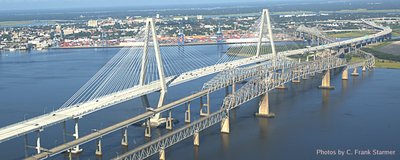The Bridge Blog
A dialog about our new bridge and these web pages
Overview.
Schools and universities are all about learning - and learning is mostlly
brain training. Learning is expedited by repetition and forgetting
is expedited by infrequent use of learned skills or information.
Tracking the building of the Ravenel Bridge and now tracking the
demolition of the Grace and Pearman Bridges bring
many questions to me and help me better understand the role Google
and the Internet play in
just-in-time learning. I enjoy chasing my curiosity and
want to identify ways to encourage younger learners to also enjoy curiosity
chasing and learning.
Many young learners do not understand the importance of repetition. More
important, while experienced learners understand the learning process
they often do not realize the destructive effects of the forgetting
process. Over the course of the
bridge project, I have access to only a few experts.
Rather than a liability, this has become an asset and pushed me to improve
my search skills with Google. Soon, I realized that answers
to questions encountered during my photo adventures were often
only a Google-search away. Gene Stead,
my first boss and I put these ideas together in a small essay:
(see
Restoring the Joy in Learning).
Google + Internet have become dependable extensions of my memory.
Insights I gain from you and this project will find their way into the
learning centers in our schools and universities.
Sun, 23 Jul 2006
July 23, 2006 Curious about double images in the pier base explosions
Many of you know that a lot of fun in my day is based on exploring data.
I have never understood why data analysis was so much fun - but as long as
I can remember, I have enjoyed looking at data, looking for common
denominators, looking for the unexpected and then trying to understand the
basis of a common denominator or explain an unexpected result.
Here are two frames from imploding the base of P-10 on July 12, 2006.
Note the double image of the wave at the base of the pier foundation and
smoke
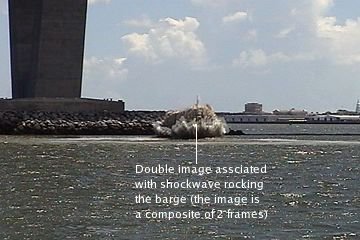
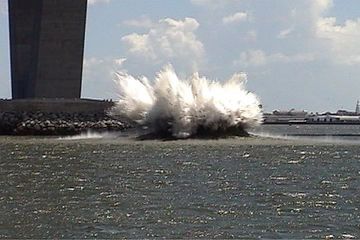
Thinking that was associated with an underwater shock wave colliding with the
barge used for video recording, I looked at the implosion of C-1 on July 14
and observed the same result - a double image
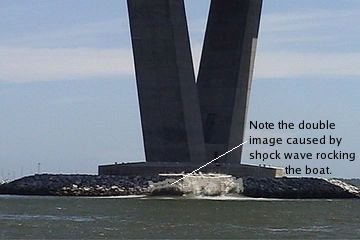
and then after several hundred milliseconds, the double image resolved into a
single image
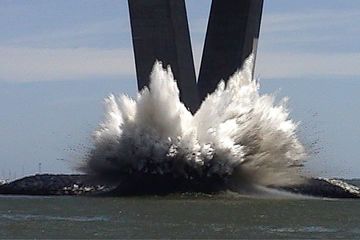
Testing whether this was associated with some sort of underwater shock wave,
I selected as a control, the above-water implosion of the C-2 pier. My
speculation was that this blast did not involve an underwater shock wave
whereas the above two blasts created an underwater shock wave
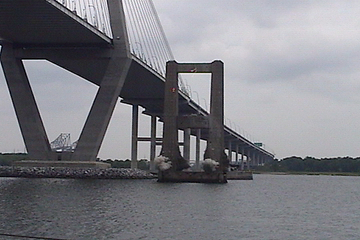
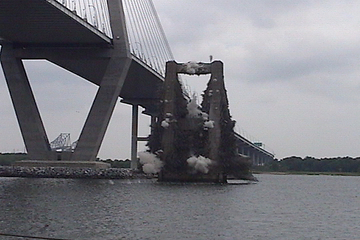
I could detect no double images with the C-2 pier implosion (above two images).
What I think is happening is that each video frame consists of two fields, one
of the even scan lines and one of the odd scan lines. When processed, the two
fields are combined which improves the resolution. One field is scanned
every 16.67 msec so I suspect that there was enough movement of the barge
between two consecutive frames to produce the double images.
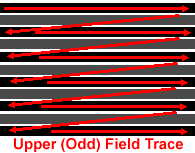
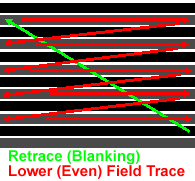
It would be interesting to superimpose the base of the rock island, behind
the pier foundations, and see if they appeared to shift up or down between
successive frames - paralleling the movement of the barge as the shock wave
passed.
posted at: 21:47 | path: | permanent link to this entry
Mon, 20 Mar 2006
March 20, 2006 Almost goodbye.
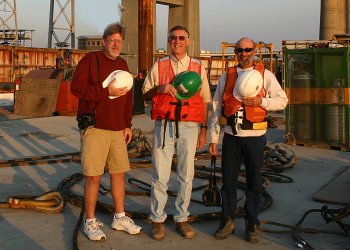
Gary Eaton,
Frank Starmer and Sparky Witte
The three muskateers of Charleston
construction photography
One cold morning in January I was watching some girders being erected on
Line 14 (the East Bay on ramp) and up drives a car and out pops a man, tripod,
camera, hard hat, safety vest - just like me. This was Gary Eaton who had
been tracking the bridge longer than I had. During the July transition from
building the Ravnel Bridge to unbuilding the Grace and Pearman Bridges,
I received some photos from Sparky Witte from Mt Pleasant. Suddenly, the
Internet provided two new friends for capturing the behind the scenes story of
the building and unbuilding processes. This started our small club of
Charleston Construction Photographers - who knows what will happen next?
While Gary is a real photographer (visit his
Studio web site),
Sparky and I were novices and eager to learn. I was very fortunate to
acquire additional Internet-initatied contacts that facilitated my learning.
Vince Streano from Seattle
provided insights about capturing construction photos while Stephen
SetteDucati from Boston and did the
Big Dig at NIght provided some insights for
night photography.
While the Internet is a useful communication tool, it is also a tool for
social interactions. I would never found Gary, Sparky, Vince or Stephen
without the Internet's ability to publish my building and unbuilding stories.
As I enter the last few day of acute loose end overload - preparing to depart
for Singapore and Duke on Thursady, I am confident that our interactions
will continue. Nugget, one of the iron work acrobats has some digital images
for our site, Sparky and Gary will continue and I suspect others will
contribute. What a wonderful time Ellen and I have had in Charleston and we
shall certainly miss it. We are keeping our home and we are keeping all the
warm friends that we have made - particularly Tom and Joan Bryce, our neighbors.
posted at: 10:20 | path: | permanent link to this entry
Sun, 05 Mar 2006
March 5, 2006: Frank's next chapter.
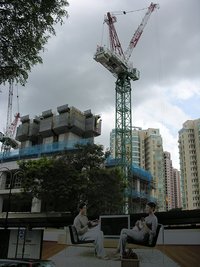 My professional life has centered around the fun of learning and my
professional home
has always been within universities. Each step of my academic career
has been fun and full of surprises - both scientific and cultural.
For 32 years I was a
faculty member at Duke in the
Departments of Medicine (Cardiology) and Computer Science. During this time
I was fortunate to stumble on the fun of international collaboration - in
France, Germany, Egypt, Spain, the USSR, starting in 1987 in Moscow at the
All Union
Center for Experimental and Clinical Cardiology. In 1991, I shifted my
collaboration to
Valentin
Krinsky's Autowave laboratory
in the Institute of Theoretical and Experimental
Biophysics in Pushchino, about 100 km south of Moscow. In parallel, I
extended my experiments with other cultures and taught for a year (1993-94) in
India (the Indian Institute
of Technology, Madras) and more recently (1997-1998) in
Greece (where I was a
Fulbright
Scholar at the University of Patras and most recently, developed a link
with the
University of Mostar, Bosnia in
2000 and in 2001.
My professional life has centered around the fun of learning and my
professional home
has always been within universities. Each step of my academic career
has been fun and full of surprises - both scientific and cultural.
For 32 years I was a
faculty member at Duke in the
Departments of Medicine (Cardiology) and Computer Science. During this time
I was fortunate to stumble on the fun of international collaboration - in
France, Germany, Egypt, Spain, the USSR, starting in 1987 in Moscow at the
All Union
Center for Experimental and Clinical Cardiology. In 1991, I shifted my
collaboration to
Valentin
Krinsky's Autowave laboratory
in the Institute of Theoretical and Experimental
Biophysics in Pushchino, about 100 km south of Moscow. In parallel, I
extended my experiments with other cultures and taught for a year (1993-94) in
India (the Indian Institute
of Technology, Madras) and more recently (1997-1998) in
Greece (where I was a
Fulbright
Scholar at the University of Patras and most recently, developed a link
with the
University of Mostar, Bosnia in
2000 and in 2001.
Now I am about to embark on another cultural adventure. The Government of
Singapore and Duke University have signed a memorandom of understanding to
build a new Graduate Medical School in Singapore. I have signed to be
part of the new faculty - led by Pat Casey in Singapore and Sandy
Williams at Duke. For
Ellen and myself, this is a like a trip back home - putting us within a few
hours flight time of our friends in South India, Bangladesh and Thailand. I
have signed a 3 year contract and will be the Associate Dean for Learning
Technologies - a continuation of my career as an engineer in the setting of
Medical Education. In addition, I suspect there will be a new Building
web site, tracking the construction of the Duke - GMS building.
The bridge building and unbuilding web sites will continue. With the members
of my former IT Lab at MUSC, we have established a server -
Butterfat that will act as an Internet
home base for these sites, and those of
web page to butterfat (
mine and my
IT Lab colleagues).
Sparky and the iron workers (Nugget and Speedy) have offered to continue
to photograph the progress with unbuilding the Grace and Pearman Bridges.
They will send me photos and the stories and I shall try to maintain the
continuity of the unbuilding process from Singapore. This will form
the core of another Frank Experiment - can we sustain our momentum
with participants located half way around the world from each
other. In addition, I shall
lean on my unbuilding friends at Jay Cashman and Testa - Ken Canty, Ponch
Billingsley, Mickey Rogers and Ken Tully at Advanced Blasting Services and the
families of Michael Hebb, Richie Bagan and Jack Foley.
You cannot imagine how much
new life and energy these folks have brought into the lives of Frank and
Ellen Starmer in Charleston.
 I am certain that there will be building and unbuilding opportunities in
Singapore and the surrounding area. For example, Oliver Forget (Freyssinet)
is now located in Bangkok and is building a new cable stay bridge there.
Marvin Tallent is in Pensacola and Peo Halvarsson is in the process of
moving back to Sweden. I shall continue to poke these friends and tell their
stories.
I am certain that there will be building and unbuilding opportunities in
Singapore and the surrounding area. For example, Oliver Forget (Freyssinet)
is now located in Bangkok and is building a new cable stay bridge there.
Marvin Tallent is in Pensacola and Peo Halvarsson is in the process of
moving back to Sweden. I shall continue to poke these friends and tell their
stories.
posted at: 15:15 | path: | permanent link to this entry
Thu, 09 Feb 2006
February 9 2006 2am: Another chapter about signature bridges
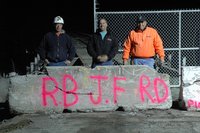 One day as I was following the building of the Ravenel Bridge, I stumbled on
a tablet on the top of the
west tower that was signed by many of the bridge workers. Hmm, I thought,
this is what a signature bridge is all about.
One day as I was following the building of the Ravenel Bridge, I stumbled on
a tablet on the top of the
west tower that was signed by many of the bridge workers. Hmm, I thought,
this is what a signature bridge is all about.
Today, though, I discovered another variant of Signature Bridges. Jackie
and Richie thought that tonight, they would unpour the last section of
Grace roadway at the Mt. Pleasant entrance. So off I went, about 8pm to
watch. At 2am Friday morning, it was complete - and - wow, what a new
meaning for signature bridge. Jack, Richie,Rich, Roy and myself - the only
witnesses to this event. Click
for the Grace signature bridge story. Huge thanks to Richie, Jackie, Rich
and Roy for the invitation!
posted at: 02:00 | path: | permanent link to this entry
Sun, 29 Jan 2006
January 29, 2006: Lessons learned from building the Ravenel Bridge.
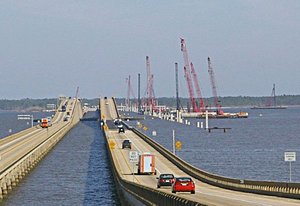 Several people have asked about how these pages got started. This is easy:
I started these web pages as a way for my grand kids to follow the
building of the Ravenel Bridge. But a number of people are curious about
my access to the building site. Several months ago, I as asked this question
during a Channel 5 TV interview and I simply replied, "I smile". It was
a serious answer.
Several people have asked about how these pages got started. This is easy:
I started these web pages as a way for my grand kids to follow the
building of the Ravenel Bridge. But a number of people are curious about
my access to the building site. Several months ago, I as asked this question
during a Channel 5 TV interview and I simply replied, "I smile". It was
a serious answer.
There are two ways to become involved in a project - the front door and
the back door. The front door is always obvious and usually opens to
a receptionist who directs you to someone. The back doors are usually
hidden, but with some practice, you can find the back doors. These doors
lead to the men and women that do the building and unbuilding.
When I started building the
Ravenel Bridge web pages, I simply took photos and wrote short photo
essays for the kids. I was not looking for either front doors or back doors.
But Bill Mankin of High Steel Structures in Lancaster Pa contacted me about
the web site - and without knowing it, opened a back door to High Steel
Structures. They fabricated the structural steel used to build the
main span. David Wertz, then with SCDOT opened doors. Somehow,
Olivier Forget of Freyssinet (in Paris) found the
web pages and opened another back door
and introduced me to the complexity and excitement of cable stay bridges. Then
Bill Mankin sent email stating that his team would be in Charleston to drill
and ream the splice plate used to join the east and west spans and maybe I would
like to watch. Not knowing what to do I phoned PBC and Marvin Tallent answered
the phone. I described Bill's request and soon Marvin introduced me to
Peo Halvarsson (superintendent of the Main Span) and Wade Watson, who directed
the entire project. Bill, David, Marvin, Peo and Olivier became my
professors of
bridge-ology and through their eyes, I saw and gained insights into the
complexity of their project. Because of them, my goal shifted from
a grand kids project to one of telling the unseen stories of bridge building.
The project ended - Wade returned to Tidewater Virginia, but Peo and Marvin
made their way to Pensacola Florida where they are working on rebuilding the
causeway (I believe, part of I-10). Our friendships have extended beyond
the completion of the Ravenel Bridge and a few days ago, Marvin sent me a
photo of their project (above) and announced that he had just purchased a new
digital SLR camera. Marvin is also a serious cyclist (of the bicycle variety -
whereas Wade was a serious cyclist of the Harley-Davidson variety). We are
keeping our eyes open for opportunituies to ride together over the Ravenel
Bridge. We did this several times before the bridge opened, but that did not
count. Somehow, riding together over the completed bridge will provide a
nice ending to the story of building the Ravenel Bridge.
When the Unbuilding project started - Ken Canty and Ponch Billingsly provided
back door access to the Pearman-Grace project. However, the web site,
I soon discovered, provided for them a way for their families in Boston
and other places to watch their husbands at work. Tina Hebb and
Kathy Billingsley were the brave souls that initially encouraged me to
engage not only
the workers here, but their families there. Their families as well as members
of other families (Hal, Joy, Shannon, Corey, Donna-Rae, Joshua) joined the
email discussions. Now they are my professors
along with Bob McCabe, Pio Monsini, Michael Hebb, Jackie Foley, Neal Meyers
and Richie Bagen. Through their eyes I have continue to learn more about
building and unbuilding - not just bridges but life. What a learning
experience these men and their families have brought to me. The lesson for
me is about sharing - first with my grand kids and then with the world.
Sharing via the Internet created social contacts that would not have
happened without the Internet. The Internet is our new learning tool and
for me, adds to the fun of the day.
posted at: 07:21 | path: | permanent link to this entry
Thu, 15 Dec 2005
December 15, 2005: Something to think about.
A holiday message from Ellen and myself to all of y'all.
Many folks do not have the possibility to see something
that is often somewhat off limits.
For me, the opportunity to look over the shoulders, initially of Wade, Peo
and Marvin with PBC and now
the Cashmen guys, the Testa guys and their subcontractors, specifically
Mickey Rogers and his ABS team has been unique. It is appropriate during
this holiday season to share with you something that is deeply personal for
me.
Yesterday, my wife found
Unbuilding at Ground Zero and Rebuilding in Iraq and I
found it so relevant to the unbuilding story that is unfolding here in
Charleston, that I want to share it with you.
The essay is an interesting assessment of William Langewiesche’s
American Ground: Unbuilding the World Trade Center. The focus of these
works is on problem solving - and more important, spontaneous problem solving
within the unbuilding trades.
I have been impressed, which is an understatement, at the problem solving
skills of all the team members that are working on the Charleston Project
whether excavator operator, iron worker, burners, supervisors,
drivers (whether truck or crew boat) and the engineering staff.
Mickey, Pio, John, Neil, Paul, Ken, Joe, Ponch
and many many others have provided
me with a small look at their world and the daily challenges they face.
From time to time, I have pointed out their innovative approaches to
a number of problems - at least as seen from my perspective (remember, I am
trained as an electrical engineer, so all of this is new to me).
When unbuilding something, one does not know
what is hiding under the roadbed until it is revealed.
I believe successful unbuilders self select themselves
because they are really good problem solvers.
From my vantage point as a university faculty member, conveying to junior
learners the problem solving and
critical thinking skills we have acquired over our career is evident in the
building and unbuiding trades but, I feel, is often overlooked within our
primary, secondary and university educational systems.
These guys pass their insights, seemingly effortlessly,
from generation to generation. Apprenticeship education and learning
by example at its best.
As we enter a new era of learning where the Internet flattens our world,
makes impossible friendships possible and provides a way for like-minded folks
to interact with each other,
it seems to me that we need to also take lessons from serious
card-carrying unbuilders and develop an understanding of
how they transfer their skills to junior learners. It is time for
our formal educational system to look critically at how the informal
educational system that I have observed within the building and unbuilding
community works - and explore ways to strengthen our interactions with
our new friends and colleagues.
A special thanks from Ellen and myself
to Michael, Tina, Richie, Kathy, Jack, Pio, John, Neil, Mickey, Joe,
Ken and Ponch for opening my eyes! (And apologies to all the others that
I did not name.)
posted at: 13:59 | path: | permanent link to this entry
Fri, 25 Nov 2005
November 25, 2005: The day after Thanksgiving and a time reflection.
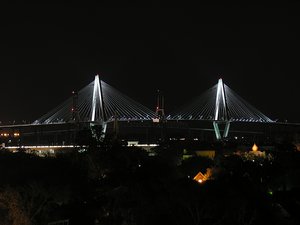 It is Thanksgiving and most of the Cashman / Testa team has made its way back
to Boston while local members have returned to their nearby homes. It is
quiet here. Josh (our youngest) and his girlfriend came for Thanksgiving.
Ellen departed from tradition, and deboned a huge chicken (10 lbs) for dinner
yesterday. Our small family enjoyed a quiet afternoon, wonderful dinner
topped by one of Ellen's impossible blackberry pies (the secret is the
crust which was passed down from her mother). Last night we visited the
top of the new MUSC parking garage and found the new Ravenel Bridge quietly
inviting us over.
It is Thanksgiving and most of the Cashman / Testa team has made its way back
to Boston while local members have returned to their nearby homes. It is
quiet here. Josh (our youngest) and his girlfriend came for Thanksgiving.
Ellen departed from tradition, and deboned a huge chicken (10 lbs) for dinner
yesterday. Our small family enjoyed a quiet afternoon, wonderful dinner
topped by one of Ellen's impossible blackberry pies (the secret is the
crust which was passed down from her mother). Last night we visited the
top of the new MUSC parking garage and found the new Ravenel Bridge quietly
inviting us over.
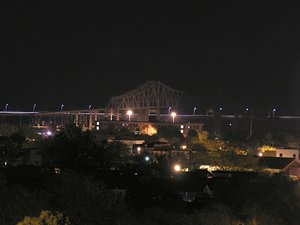 To the right was the shadow of the remaining Pearman cantilever section. Just
visible, but somehow it fit my mood.
Today I took Josh and Bibi for a survey of the bridge work. Bibi is an
Art History expert and the interplay of the bridge structures
and early morning or late afternoon sun makes for very interesting images.
Earlier Bibi looked (probably after being forced by me) to look at a few
of the videos I made of our mostly Boston surgeons - and her immediate
impression was the care and slow and deliberate way the operators move
material from A to B. It was my impression from many months ago. For
her to catch it immediately gave me a bit of satisfaction that the
photos and videos are, indeed, capturing some of the skillful approach
the unbuilding team takes with their work.
To the right was the shadow of the remaining Pearman cantilever section. Just
visible, but somehow it fit my mood.
Today I took Josh and Bibi for a survey of the bridge work. Bibi is an
Art History expert and the interplay of the bridge structures
and early morning or late afternoon sun makes for very interesting images.
Earlier Bibi looked (probably after being forced by me) to look at a few
of the videos I made of our mostly Boston surgeons - and her immediate
impression was the care and slow and deliberate way the operators move
material from A to B. It was my impression from many months ago. For
her to catch it immediately gave me a bit of satisfaction that the
photos and videos are, indeed, capturing some of the skillful approach
the unbuilding team takes with their work.
posted at: 14:53 | path: | permanent link to this entry
Sun, 06 Nov 2005
November 6, 2005: Sunday - a day of rest and reflection.
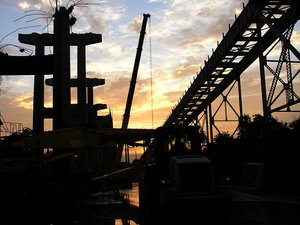 University life restarted in late August. This makes my double
life rather hectic - trying to capture the bridge unbuilding
during the early morning, late afternoon and evenings.
Unbuilding has a rapid pace while building (the Ravenel
Bridge) was slower and a bit more predictable. The fast-paced unbuilding,
though, has opened new doors for me and brought new friendships. But to
track all that is going on - well, its impossible at least for me.
University life restarted in late August. This makes my double
life rather hectic - trying to capture the bridge unbuilding
during the early morning, late afternoon and evenings.
Unbuilding has a rapid pace while building (the Ravenel
Bridge) was slower and a bit more predictable. The fast-paced unbuilding,
though, has opened new doors for me and brought new friendships. But to
track all that is going on - well, its impossible at least for me.
But there has been a big surprise for me. With the unbuilding project
has come lots of email from wifes, kids and relatives of the Testa and
Cashman teams. While I had a little email from the Ravenel families,
the Testa / Cashman families have brought a new dimension to these pages. I
have to thank Tina Hebb, Maura Bickford (Jack Foley's sister), Donna
(Jack's aunt) and Kathy Billingsley for adding this new dimension to
our web pages. Kathy is faced with the empty
nest syndrome back in Boston with her husband and her 2 "boys" working on the
project. From time to time, she reminds me that I missed an update. So the
Internet has really flattened our world - and geographic separation
does not seem to get in the way of developing friendships between people
I have never geographically met.
Meanwhile back on the work site,
work is mostly 24 hours/day - a 12 hour morning shift and a 12 hour
night shift. The teams are dynamic - and some members of the day shifts are
moved to the evening shift and that makes identifying teams and meeting
them and learning something of their work and life a challenge. I have
managed to meet most of the team leaders - Bob McCabe, Neil Myers, Pio
Monsini and Paul Leary. Ponch Billingsley seems to have his fingers
everywhere and is moving from site to site, along with Steve Testa - sort
of roaming symphony conductors who refuse to remain standing on a single
platform. Moreover, Joe Duffey and Ken Canty are into everything. One
afternoon I was watching Mike Hebb hammer away at a Pearman column (at the
Port) and Joe walks up and we talk about what is happening. Later that night I
found Jack Foley and Roy Delpriete segmenting concrete girders. Joe was
there also.
Early one morning (about 4am)
I caught some of the cleanup from removing roadway over the East Bay ramp
to the Ravenel bridge. Then about 10 that night I was watching Neil's team
pick up the concrete girders over the East Bay ramp. Each time I ran into
Joe. And Ponch was multi-tasking - directing traffic, running a front
loader (to set up for the 7550) - you name it, these guys are all over it.
They truly reflect a highly skilled surgical team that is continuously
fascinates me. No boring jobs here - there are always surprises. But
my memory is a problem. Recently I renamed Chris Vocci as Cecil - who
runs the 7550 giant crane. Earlier I mixed Jack Foley and Michael Hebb.
These guys and/or their families quickly point out my errors and so,
help improve the accuracy of this story.
Recently I met Mickey Rogers whose Advanced Blasting Services is responsible
for the concrete explosive work. Mickey has become another of my professors
and helped me to understand the preparation of the columns for explosive
removal. As the project moves into its explosive stage, I shall bring more
of the insights from these teams - as they teach me something of their
art.
posted at: 07:53 | path: | permanent link to this entry
Mon, 19 Sep 2005
September 19, 2005: Another kind of construction, reconstruction and demolition.
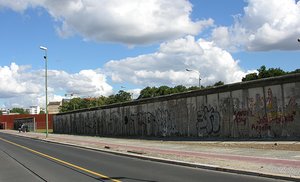 From time to time, I have experienced a convergence of events that can, by
no means, be a coincidence. Last Thursday I visited friends that were
my PhD students while I was a Fulbright Scholar at the University of
Patras in Greece. As husband and wife, life is a bit strained at the
moment with one working in Patras and the other working as a Post doctoral
fellow in the Physics Department at the University of Potsdam, German. Potsdam
is just outside Berlin and so I spent the weekend with them in Berlin. Friday
was raining so we spent it at the University. Saturday was blue sky everyone
with cotton puffs for clouds.
From time to time, I have experienced a convergence of events that can, by
no means, be a coincidence. Last Thursday I visited friends that were
my PhD students while I was a Fulbright Scholar at the University of
Patras in Greece. As husband and wife, life is a bit strained at the
moment with one working in Patras and the other working as a Post doctoral
fellow in the Physics Department at the University of Potsdam, German. Potsdam
is just outside Berlin and so I spent the weekend with them in Berlin. Friday
was raining so we spent it at the University. Saturday was blue sky everyone
with cotton puffs for clouds.
I had two requests - to visit the Brandenburg Gate and to visit the Wall. The
story goes like this. In November of 1989, a colleague from the University
of Freiberg. During dinner we discussed as a family, what was happening
in Eastern Europe. Each day, stories of trains of refugees passing through
Hungary and into German became stronger and stronger. I asked my friend,
what about the Berlin wall - will it ever come down. Without hesitation,
he replied - "not during my life". Later we turned the TV on and watched the
evening news as the Berlin Wall was coming down. So to visit Berlin and not
touch the wall - impossible.
Here is the Brandenburg Gate - as seen from the north and from the
south
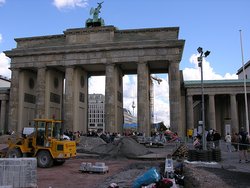
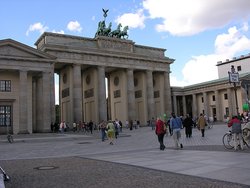
I was a big fan of John le Carre - a British spy novelist - and
the Brandenburg Gate was a point of spy exchanges - Checkpoint Charlie.
More strong emotions here than I expected - and a more complete story
is included in the
stories
page
As you can see, there is construction in Berlin, reconstruction and
memorials of past structions designed to contain and restrain interactions
among free people.
posted at: 13:26 | path: | permanent link to this entry
Wed, 14 Sep 2005
September 14, 2005: Fixing the Grace Bridge
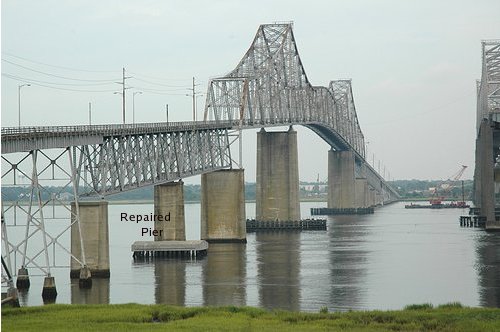
Lee Graves in Tomball Texas found our web site and contributed
the following story from his father, James R. Graves, senior
designer of the Pearman Bridge.
"I recently discovered your website showing the "unbuilding" of the old
bridges. My father, James R. Graves, was the senior designer of the old
Pearman bridge so I feel a real connection with the two bridges. Several
years later he was made Bridge Engineer of the SC Highway Department. You
probably do not know a very interestoing story regarding the old Grace
bridge. During construction of the Pearman bridge, it was discovered that
the old timber pilings supporting the first pier of the old bridge on the
Charleston side were virtually eaten away by marine worms and the old bridge
was in real danger of collapsing, and in fact the old bridge was leaning
several feet out of plumb. It was decided to put a cable around the old
pier, pull it back into alignment, and pour a concrete casing around the
remains of the timber pilings. When the old bridge is demolished down to
the piers, you might take a close look at the footing of that first pier."
And just to keep life interesting - here is today's projection of
Hurricane Ophelia. Ophelia has been just sort of chillin' out a bit - about
150 miles east of Charleston. NOAA provides a very useful service with
their projections and advisories. I've included these on the main bridge
web page. We have a more compresensive
aggregation of weather related
images at MUSC.
Infrared Image and the NOAA projection (click image for full presentation
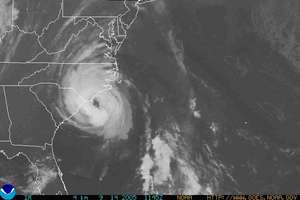
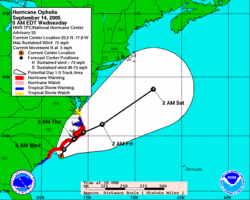
posted at: 09:19 | path: | permanent link to this entry
Sun, 28 Aug 2005
August 28, 2005: My surprise: The skill and precision of demolition
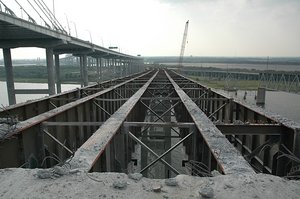 I suppose I always thought that demolition was just another destructive
process - that of removing components until all the structure was reduced
to a pile of rubble. Was I ever wrong. Watching and talking with the
Testa and Jay Cashman guys, I have found that there is skill, precision and
a bit of art in their work. Skill to work the giant grapples, jackhammers
and shears. Precision in removing segments of the road, cleaning the
underlying I-beam surfaces (on the Grace and Pearman bridges) or cutting
the rebar that formed the concrete supporting structures along the
Grace and Pearman approaches and exits and art - somehow instinctively knowing
what and where to apply their what I call, surgical tools.
I suppose I always thought that demolition was just another destructive
process - that of removing components until all the structure was reduced
to a pile of rubble. Was I ever wrong. Watching and talking with the
Testa and Jay Cashman guys, I have found that there is skill, precision and
a bit of art in their work. Skill to work the giant grapples, jackhammers
and shears. Precision in removing segments of the road, cleaning the
underlying I-beam surfaces (on the Grace and Pearman bridges) or cutting
the rebar that formed the concrete supporting structures along the
Grace and Pearman approaches and exits and art - somehow instinctively knowing
what and where to apply their what I call, surgical tools.
Just as I learned of the precision (fractions of an inch) required to
join the edge girders of the new Ravenel Bridge, I have learned from the
Cashman and Testa workers that unbuilding requires similar precision. I
was trained as an electrical engineer - where precision was part of the
discipline. I suppose I was quite guilty of looking at my civil
engineering colleagues as working with precision that was less demanding and
"close enough for highway work". Was I ever wrong! I have totally
reversed my understanding of demolition over the short month
since the demolition of the Grace and Pearman bridges and approaches
started. Another demonstration that even at my age (64 next week) -
continued learning is possible and even necessary.
posted at: 08:35 | path: | permanent link to this entry
Tue, 16 Aug 2005
August 13, 2005: Another very pleasant surprise
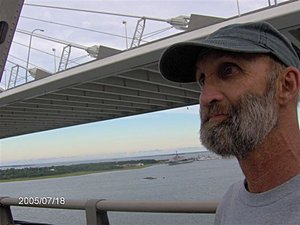 Sparky Witte, a long time resident of Mt. Pleasant, grew up with the Grace and
Pearman bridges. With the Ravenel bridge he has enjoyed being able to walk and
bicycle across the bridge, admiring Mt. Pleasant to the east and Charleston to
the west. He also can watch the unbuilding of the Grace and Pearman bridges.
Sparky Witte, a long time resident of Mt. Pleasant, grew up with the Grace and
Pearman bridges. With the Ravenel bridge he has enjoyed being able to walk and
bicycle across the bridge, admiring Mt. Pleasant to the east and Charleston to
the west. He also can watch the unbuilding of the Grace and Pearman bridges.
Last night, Sparky sent me a group of photos of the July 30 events - the
race and the old car parade. Moreover, he had taken quite a bit of time to
track the demolition of the I-26 and Meeting Street overpasses. I was unable
to stay for all the I-26 work Sunday morning and missed completely the
Meeting Street overpass demolition. So here is part of Sparky's gift - a group
of photos that provided timely tracking of the unbuilding process.
I have added the Meeting Street work to the main page
(tracking the progress over the past days) as well as to the
Meeting St.
page. His photos of the extraction of one set of supporting piers (and cap)
as been added to the
Engineering Challenges page.
Among his photos was one of him - posted above. Clearly, Sparky has brought
new life to our web page, adding photo input to the engineering input I receive
from many people. Sparky - you're the greatest!
posted at: 16:27 | path: | permanent link to this entry
Sat, 13 Aug 2005
August 13, 2005: A suggestion to Mayor Riley and the Transportation Board
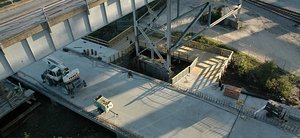 During the construction of the Morrison Street on-ramp, bicycle and pedestrian
walkway, there was an obstacle at the base of the Pearman bridge. A vertical
support structure prevented paving a small section of the bicycle lane. A
small wooden platform was built around the Pearman supports - a sort of
detour.
During the construction of the Morrison Street on-ramp, bicycle and pedestrian
walkway, there was an obstacle at the base of the Pearman bridge. A vertical
support structure prevented paving a small section of the bicycle lane. A
small wooden platform was built around the Pearman supports - a sort of
detour.
With the demolition of the Pearman and Grace moving ahead (briskly), I
understand that this platform will be removed when the vertical supports
are removed, then bicycle lane paving will be completed.
But what a perfect spot to place a few park benches
so that walkers can stop, rest and contemplate not only our wonderful
bridge, but life, the universe and everything. So what about this option,
is it possible to modify the contract with Cashman-Testa to not remove
the wooden platform and for the City to populate it with a few park
benches - particularly useful to maturing adults (age > 60)?
posted at: 08:08 | path: | permanent link to this entry
Thu, 11 Aug 2005
August 11, 2005: A little weather and a little web page design.
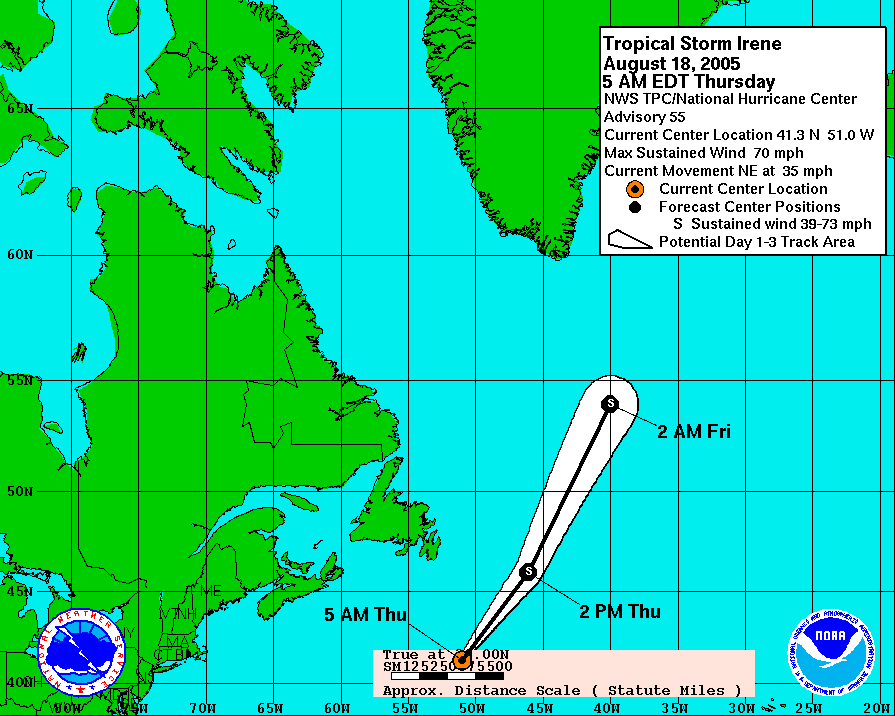 During the construction of the Ravenel
Bridge hurricane cables were installed to provide some lateral stability
under high wind loads. At the same time, I was exploring how to harvest
weather data from NOAA and the National Hurricane Center so that MUSC
faculty, staff, students and worried parents of students (and perhaps worried
parents of faculty / staff) could view primary data without visiting
multiple web sites.
During the construction of the Ravenel
Bridge hurricane cables were installed to provide some lateral stability
under high wind loads. At the same time, I was exploring how to harvest
weather data from NOAA and the National Hurricane Center so that MUSC
faculty, staff, students and worried parents of students (and perhaps worried
parents of faculty / staff) could view primary data without visiting
multiple web sites.
The National Hurricane Center in Miami
provides
RSS (Rich Site Summary) feeds that are small, Internet accessible,
data files that include
links to weather advisories and storm projection graphics. From these links
we wrote a short script to periodically download the updated advisories and
satellite imagery and storm projections. Our
MUSC site presents this
and other harvested data on a single web page.
For the demolition project, I thought it would be useful to present a
minimum set of data so all of us could follow the interactions between
the weather and bridge demolition. Now, Satya Phanse, one of my guys in
the IT Lab thought it would be
useful to selectively display or hide my introductory remarks and worked
out a short segment of
javascript that enables you to display or hide web page segments.
I learn by example, so I copied Satya's example, adapted it to our
bridge page and after 1 mistake (mine) - it works.
posted at: 08:00 | path: | permanent link to this entry
Wed, 10 Aug 2005
August 10, 2005: Demolition in full swing
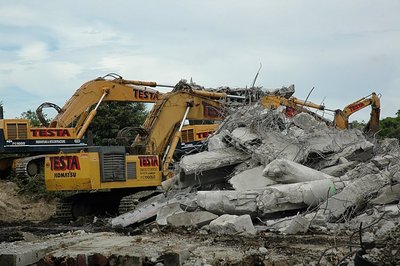 While I always understood that building required more time than
unbuilding I never really felt the difference. Tracking the
construction of the Ravenel Bridge, in retrospect, was a leisurely activity.
Tracking the demolition (I prefer unbuilding) of the Grace and Pearman
structures (bridges as well as approaches) is turning into a twice daily
affair - early morning (6am) and early evening (6pm). I'll keep this
schedule as long as possible. The folks at Jay Cashman - Testa have
been fantastic and helped me understand not only the demolition process
but the sequencing required to manage demolition without shutting Charleston
down for 6 months.
While I always understood that building required more time than
unbuilding I never really felt the difference. Tracking the
construction of the Ravenel Bridge, in retrospect, was a leisurely activity.
Tracking the demolition (I prefer unbuilding) of the Grace and Pearman
structures (bridges as well as approaches) is turning into a twice daily
affair - early morning (6am) and early evening (6pm). I'll keep this
schedule as long as possible. The folks at Jay Cashman - Testa have
been fantastic and helped me understand not only the demolition process
but the sequencing required to manage demolition without shutting Charleston
down for 6 months.
posted at: 09:24 | path: | permanent link to this entry
Thu, 21 Jul 2005
July 21, 2005: Transition from building to unbuilding
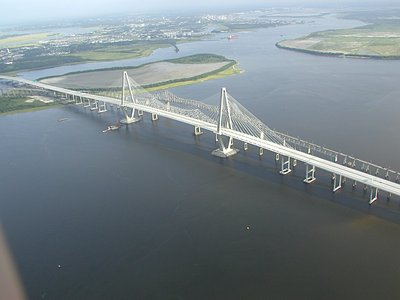
The construction of the new Cooper River Bridge is complete. The
fireworks and opening ceremony, from my perspective, breathed new
life into our community. Certainly use of the bicycle
and pedestrian walkway during the first days demonstrated both their
utility and the vision of the bridge sponsors.
There is a first chapter and a last chapter with every story and
our bridges are no different. I have started preparations for
keeping our stories alive, now as historical documents. As a
first step, I am moving the Internet address of the Ravenel Bridge story to
http://ravenelbridge.net. This
will provide a stable location and facilitate transition of the site
to a future home, perhaps the Charleston Public Library or the
Historical Society. I have not explored this with any agency, but it
seems to me that our web site (yes, not mine) would be better preserved
under the leadership of a public agency.
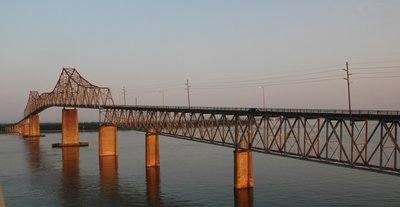
Yesterday I started the first chapter of the unbuilding of the
Grace and Pearman bridges. I have moved the Internet address for
our new story to
http://oldcooperriverbridge.org. I shall continue to take
weekly, and in some cases, daily (early morning and late afternoon)
photos of the Charleston approaches, Mt. Pleasant approaches and
the main bridge spans. In addition, I will build a new section
addressing engineering issues and insights, similar to the
Engineering and
Close-ups section I developed around the construction of the
Ravenel bridge.
Many of you have fed me ideas and questions. As we start our new
story, please continue to write me. Let our learning continue!.
posted at: 13:16 | path: | permanent link to this entry
Sat, 16 Jul 2005
July 16, 2005: The meaning of a signature bridge
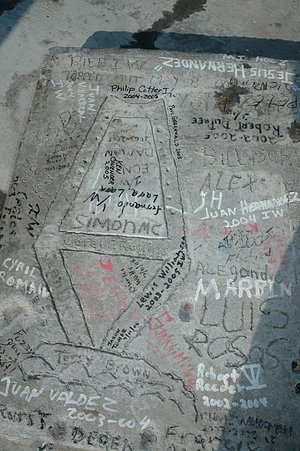 Yesterday, Vince Streano, David Wertz and I revisited the top of the
west tower. It was almost 1 year ago (July 21, 2004) that David and
I visited the top of the west tower - at that time looking at a number of
bridge engineering issues. Among them was the cabling process managed
by Olivier Forget from Freyssinet
- and the time was near the end of "le Tour de France". During an
earlier visit to the top of the west tower, I noticed a concrete tablet
on the floor (upper left) with the names of many of the construction
workers. Dumb Frank did not record this photographically at the time. This
time I was not going to repeat the same mistake twice. Not only did I take
several photos of the tablet, but I found Philip Cotter's and Lewis
Williamson's names on the tablet. Philip and Lewis are iron workers, a
very special breed of man that suspended themselves while erecting
edge and floor girders and placing the concrete floor panels. Philip's wife,
Tina, exchanged a number of emails with me about Philip and his
artistic and literary skill - naming the last main-span crane (east side)
the "Last Dinosaur Standing" (see
for the dinosaur story).
Yesterday, Vince Streano, David Wertz and I revisited the top of the
west tower. It was almost 1 year ago (July 21, 2004) that David and
I visited the top of the west tower - at that time looking at a number of
bridge engineering issues. Among them was the cabling process managed
by Olivier Forget from Freyssinet
- and the time was near the end of "le Tour de France". During an
earlier visit to the top of the west tower, I noticed a concrete tablet
on the floor (upper left) with the names of many of the construction
workers. Dumb Frank did not record this photographically at the time. This
time I was not going to repeat the same mistake twice. Not only did I take
several photos of the tablet, but I found Philip Cotter's and Lewis
Williamson's names on the tablet. Philip and Lewis are iron workers, a
very special breed of man that suspended themselves while erecting
edge and floor girders and placing the concrete floor panels. Philip's wife,
Tina, exchanged a number of emails with me about Philip and his
artistic and literary skill - naming the last main-span crane (east side)
the "Last Dinosaur Standing" (see
for the dinosaur story).
Here, permanently placed on the top of the west tower is a symbol of the
worker's bride. Many signatures are absent - but the pride runs all the
way from Bobby Clair through Wade, Peo, Marvin, David and Olivier all the
way to me - as these folks opened doors that enabled me to bring to you
much of the untold stories behind building our Arthur Ravenel Jr. Bridge.
And a final note about the Internet and learning. The Internet provided
me a medium that enabled me to share with you what the bridge folks shared
with me. Not only that, the Internet provided a communication medium that
linked me with Bill Mankin at High Steel, with engineers at the Federal
Highway Administration, Bridge Division, with Buckland and Taylor,
T. Y. Lin, HDR, Freyssinet and Tidewater Skanska. Governor Sanford
and Bob O'Brien even provided input. In the end, Bob has suggested
that I explore transfering
this web site to the Historical Society or the Library -
a wonderful strategy for breathing new life into these pages.
So from me - smiles and a big thank you to all of you!
Frank Starmer, Medical University of South Carolina.
posted at: 13:02 | path: | permanent link to this entry
